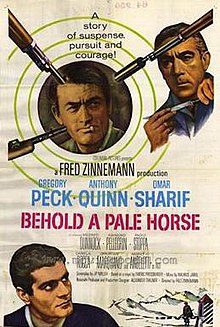
Francisco Franco Bahamonde was a Spanish military general who led the Nationalist forces in overthrowing the Second Spanish Republic during the Spanish Civil War and thereafter ruled over Spain from 1939 to 1975 as a dictator, assuming the title Caudillo. This period in Spanish history, from the Nationalist victory to Franco's death, is commonly known as Francoist Spain or as the Francoist dictatorship.

Alfred Zinnemann was an Austrian-American film director and producer. He won four Academy Awards for directing and producing films in various genres, including thrillers, westerns, film noir and play adaptations. He began his career in Europe before emigrating to the US, where he specialized in shorts before making 25 feature films during his 50-year career.
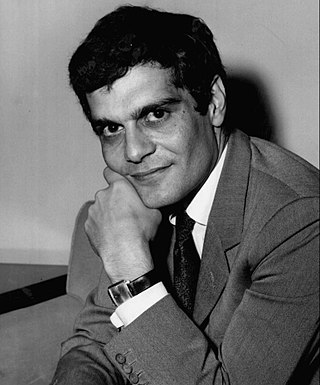
Omar Sharif was an Egyptian actor, generally regarded as one of his country's greatest male film stars. He began his career in his native country in the 1950s. He is best known for his appearances in American, British, French, and Italian productions. His career encompassed over 100 films spanning 50 years, and brought him many accolades including three Golden Globe Awards and a César Award for Best Actor.

Francoist Spain, also known as the Francoist dictatorship, was the period of Spanish history between 1936 and 1975, when Francisco Franco ruled Spain after the Spanish Civil War with the title Caudillo. After his death in 1975, Spain transitioned into a democracy. During this time period, Spain was officially known as the Spanish State.
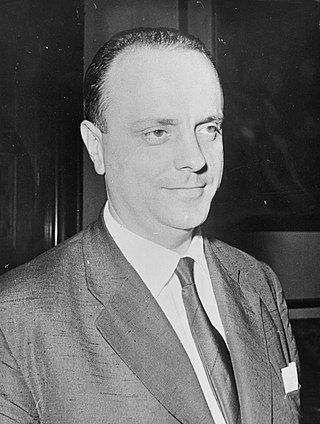
Manuel Fraga Iribarne was a Spanish professor and politician during the dictatorship of Francisco Franco, who was also one of the founders of the People's Party. Fraga was Minister of Information and Tourism between 1962 and 1969, Ambassador to the United Kingdom between 1973 and 1975, Minister of the Interior in 1975, Second Deputy Prime Minister between 1975 and 1976, President of the People's Alliance/People's Party between 1979 and 1990 and President of the Regional Government of Galicia between 1990 and 2005. He was also a Member of the Congress of Deputies and a Senator.

Mackenna's Gold is a 1969 American Western film directed by J. Lee Thompson, starring an ensemble cast featuring Gregory Peck, Omar Sharif, Telly Savalas, Ted Cassidy, Camilla Sparv and Julie Newmar in lead roles. It was photographed in Super Panavision 70 and Technicolor by Joseph MacDonald, with original music by Quincy Jones.

Perrette Pradier was a French actress and dubbing director. She is best known for her work as a voice actress which earned her the nickname of "Queen" or "High Priestess" of dubbing.

Carlos Arias Navarro, 1st Marquess of Arias Navarro was the prime Minister of Spain during the final years of the Francoist dictatorship and the beginning of the Spanish transition to democracy.
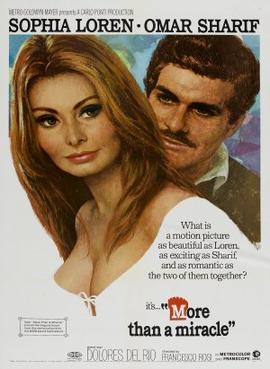
More Than a Miracle is a 1967 film also titled Cinderella Italian Style and Happily Ever After. It stars Sophia Loren, Omar Sharif and Dolores del Río. The movie has a fairy tale narrative. Filmed in the countryside outside Naples, Francesco Rosi directed and Carlo Ponti produced. The theme music was a hit for Roger Williams, reaching #2 on Billboard's survey. Sergio Franchi recorded the title song on his 1968 RCA Victor album, I'm a Fool To Want You.
The 20th Golden Globe Awards, honoring the best in film and television for 1962, were held on March 5, 1963.
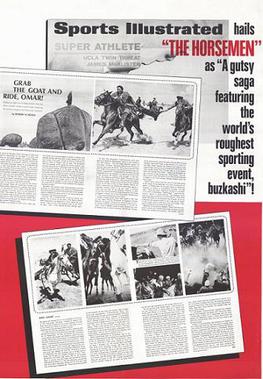
The Horsemen is a 1971 American adventure film starring Omar Sharif, directed by John Frankenheimer; screenplay by Dalton Trumbo. Based on a 1967 novel by French writer Joseph Kessel, Les Cavaliers shows Afghanistan and its people the way they were before the wars that wracked the country, particularly their love for the sport of buzkashi. The film was filmed in Afghanistan and Spain.

The Mercenary, known in the UK as A Professional Gun, is a 1968 Zapata Western film directed by Sergio Corbucci. The film stars Franco Nero, Jack Palance, Tony Musante, Eduardo Fajardo and Giovanna Ralli, and features a musical score by Ennio Morricone, taking inspiration from his work in Guns for San Sebastian, and Bruno Nicolai.

El jardín de las delicias, also known as The Garden of Delights in English language cinema, is a 1970 Spanish drama film co-written and directed by Carlos Saura.
The Pact of Forgetting is the political decision by both leftist and rightist parties of Spain to avoid confronting directly the legacy of Francoism after the death of Francisco Franco in 1975. The Pact of Forgetting was an attempt to move on from the Civil War and subsequent repression and to concentrate on the future of Spain. In making a smooth transition from autocracy and totalitarianism to democracy, the Pact ensured that there were no prosecutions for persons responsible for human rights violations or similar crimes committed during the Francoist period. On the other hand, Francoist public memorials, such as the mausoleum of the Valley of the Fallen, fell into disuse for official occasions. Also, the celebration of "Day of Victory" during the Franco era was changed to "Armed Forces Day" so respect was paid to both Nationalist and Republican parties of the Civil War.

Montse Armengou Martín is a Spanish journalist, investigative documentary filmmaker.

And in the Third Year, He Rose Again is a 1980 Spanish comedy film directed by Rafael Gil. It is based on a best-selling novel by Fernando Vizcaíno Casas.
The Sabaté brothers Quico and Pepe were among the famed Catalan Spanish maquis and urban guerrilla of the Francoist post-Civil War period. They participated in an anarchist guerrilla vigilante group of expropriators before the war. Afterwards, as maquis, they turned their focus from unlikely anarchist mass insurrection to converting others to anti-Francoism. The maquis descended from exile in the French Pyrenees to the Barcelona area, attacking Francoists and continuing vigilante robberies as a form of propaganda by deed. Their youngest brother, Manolo, rode with another maquis in defiance of his brothers' request that he pursue other work. Manolo was quickly caught in a police trap and executed by firing squad in 1949 at Barcelona's El Camp de la Bóta, the notorious execution grounds of the Franco period.
A War in Hollywood is a 2008 Spanish documentary biography historical film directed by Oriol Porta. It is about the Spanish Civil War which affected Hollywood artists such as Alvah Bessie.
Black Bread is a semi-autobiographical novel published by the Catalan pedagogue, journalist and writer, Emili Teixidor i Viladecàs in 2003, when the author was seventy years old, it describes the coming of age of a young boy in the repressive aftermath of the Spanish Civil War in rural Catalonia.
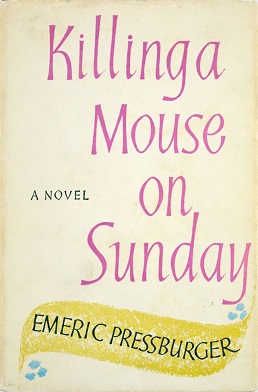
Killing a Mouse on Sunday is a 1961 thriller novel by the British-Hungarian writer Emeric Pressburger, best known as a film producer. In Francoist Spain a Civil Guard officer attempts to lure a notorious exiled guerilla fighter back across the border from France.
